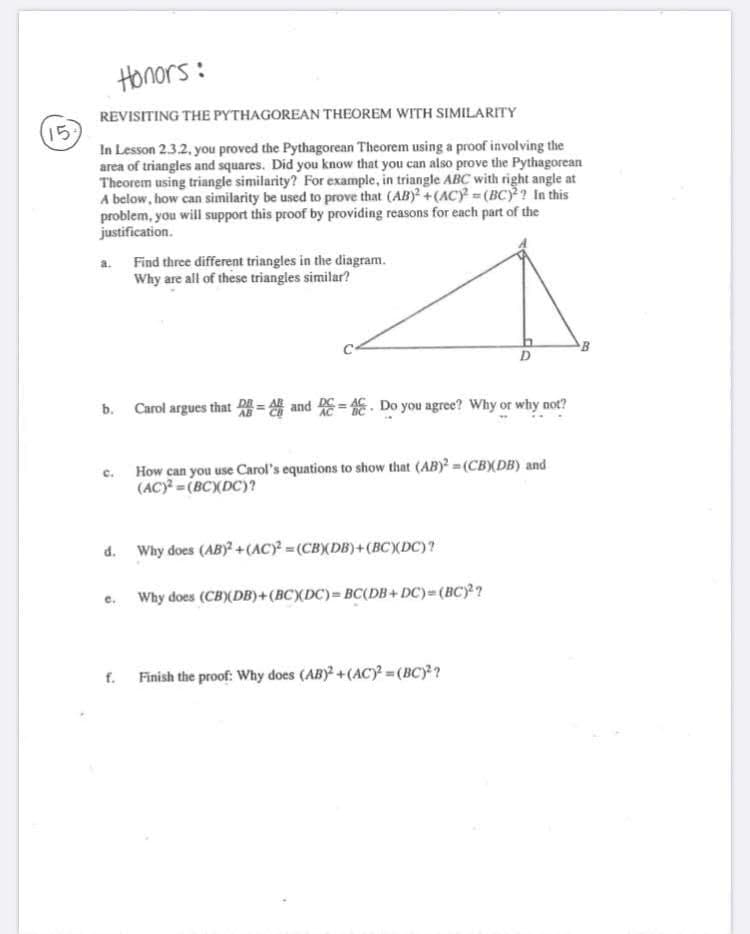Honors : REVISITING THE PYTHAGOREAN THEOREM WITH SIMILARITY 15 In Lesson 2.3.2. you proved the Pythagorean Theorem using a proof involving the area of triangles and squares. Did you know that you can also prove the Pythagorean Theorem using triangle similarity? For example, in triangle ABC with right angle at A below, how can similarity be used to prove that (AB) +(AC)² = (BC) ? In this problem, you will support this proof by providing reasons for each part of the justification. a. Find three different triangles in the diagram. Why are all of these triangles similar? B b. Carol argues that and -16. Do you agree? Why or why not? How can you use Carol's equations to show that (AB) -(CBXDB) and (AC) = (BCXDC)? d. Why does (AB) +(AC) (CBXDB)+(BCX(DC)? e. Why does (CB(DB)+(BCXDC)= BC(DB+ DC)= (BC)?? f. Finish the proof: Why does (ABY +(ACy? = (BC) ?
Honors : REVISITING THE PYTHAGOREAN THEOREM WITH SIMILARITY 15 In Lesson 2.3.2. you proved the Pythagorean Theorem using a proof involving the area of triangles and squares. Did you know that you can also prove the Pythagorean Theorem using triangle similarity? For example, in triangle ABC with right angle at A below, how can similarity be used to prove that (AB) +(AC)² = (BC) ? In this problem, you will support this proof by providing reasons for each part of the justification. a. Find three different triangles in the diagram. Why are all of these triangles similar? B b. Carol argues that and -16. Do you agree? Why or why not? How can you use Carol's equations to show that (AB) -(CBXDB) and (AC) = (BCXDC)? d. Why does (AB) +(AC) (CBXDB)+(BCX(DC)? e. Why does (CB(DB)+(BCXDC)= BC(DB+ DC)= (BC)?? f. Finish the proof: Why does (ABY +(ACy? = (BC) ?
Holt Mcdougal Larson Pre-algebra: Student Edition 2012
1st Edition
ISBN:9780547587776
Author:HOLT MCDOUGAL
Publisher:HOLT MCDOUGAL
Chapter10: Measurement, Area, And Volume
Section: Chapter Questions
Problem 30CP
Related questions
Question

Transcribed Image Text:Honors :
REVISITING THE PYTHAGOREAN THEOREM WITH SIMILARITY
15
In Lesson 2.3.2, you proved the Pythagorean Theorem using a proof involving the
area of triangles and squares. Did you know that you can also prove the Pythagorean
Theorem using triangle similarity? For example, in triangle ABC with right angle at
A below, how can similarity be used to prove that (AB) +(AC) (BC)? In this
problem, you will support this proof by providing reasons for each part of the
justification.
a. Find three different triangles in the diagram.
Why are all of these triangles similar?
B
b. Carol argues that and E= E. Do you agree? Why or why not?
How can you use Carol's equations to show that (AB)? = (CBX(DB) and
(AC) = (BCXDC)?
d. Why does (AB)+(AC)=(CBXDB)+(BCXDC)?
e. Why does (CB)(DB)+(BCXDC)= BC(DB+ DC)= (BC)²?
f. Finish the proof: Why does (ABY +(ACy =(BC)?
Expert Solution
This question has been solved!
Explore an expertly crafted, step-by-step solution for a thorough understanding of key concepts.
This is a popular solution!
Trending now
This is a popular solution!
Step by step
Solved in 2 steps with 1 images

Knowledge Booster
Learn more about
Need a deep-dive on the concept behind this application? Look no further. Learn more about this topic, advanced-math and related others by exploring similar questions and additional content below.Recommended textbooks for you

Holt Mcdougal Larson Pre-algebra: Student Edition…
Algebra
ISBN:
9780547587776
Author:
HOLT MCDOUGAL
Publisher:
HOLT MCDOUGAL

Mathematics For Machine Technology
Advanced Math
ISBN:
9781337798310
Author:
Peterson, John.
Publisher:
Cengage Learning,

Elementary Geometry For College Students, 7e
Geometry
ISBN:
9781337614085
Author:
Alexander, Daniel C.; Koeberlein, Geralyn M.
Publisher:
Cengage,

Holt Mcdougal Larson Pre-algebra: Student Edition…
Algebra
ISBN:
9780547587776
Author:
HOLT MCDOUGAL
Publisher:
HOLT MCDOUGAL

Mathematics For Machine Technology
Advanced Math
ISBN:
9781337798310
Author:
Peterson, John.
Publisher:
Cengage Learning,

Elementary Geometry For College Students, 7e
Geometry
ISBN:
9781337614085
Author:
Alexander, Daniel C.; Koeberlein, Geralyn M.
Publisher:
Cengage,

Elementary Algebra
Algebra
ISBN:
9780998625713
Author:
Lynn Marecek, MaryAnne Anthony-Smith
Publisher:
OpenStax - Rice University